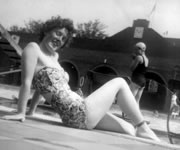Project Story

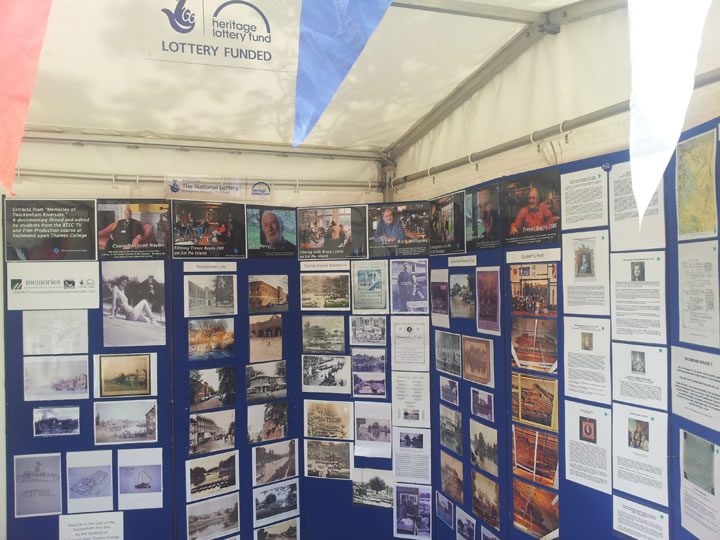
Project exhibition 23 June 2012
Diamond Jubilee Gardens, Twickenham
Memories of Twickenham Riverside
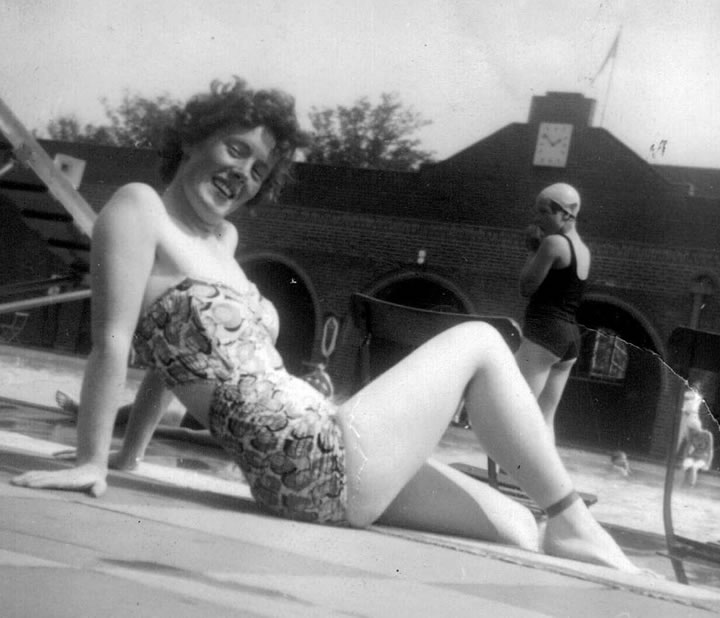
Kathleen Toberty at Twickenham Lido August 1955
Courtesy Clare Toberty
“Memories of Twickenham” Riverside is a community project focused on Twickenham Riverside which celebrates the rich heritage of this area through an oral history; much of Twickenham’s character is bound up in its connection with the Thames.
The project covers a period of living memory from the 1930s to the present day. However, since recent history has been affected by earlier events the project has recorded the results of historical research.
The project sites are the former Twickenham Riverside open-air swimming pool; Richmond House; Charlie Shore’s Boat House; Queen’s Hall and Eel Pie Island; and Twickenham Rowing Club:
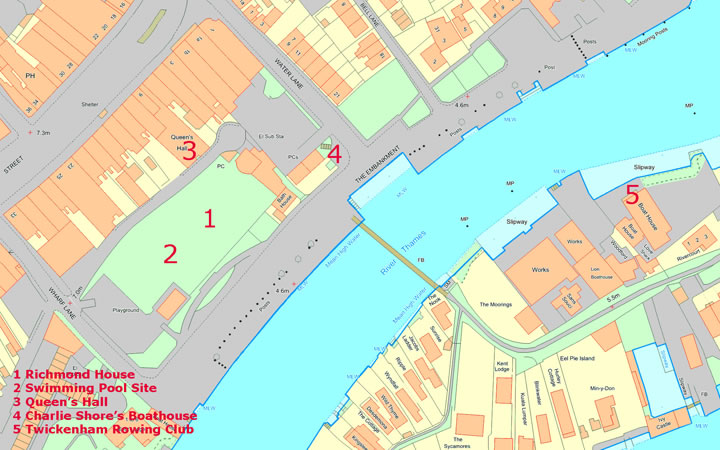
Map of project locations
The disused Twickenham Riverside open-air pool site (opened in 1935 and closed in 1980) has been the focus of a 30 year campaign to keep the land for community use. It is part of the former grounds of Richmond House, demolished in the 1920s. Next to the pool site is the old site of Charlie Shore’s Boat House, known for its Water Carnival and Regatta, which ended soon after the Second World War. Between the old pool site and the site of Charlie Shore’s Boat House is Queen’s Hall, now in need of restoration, and famous for the debut of Lilly Langtry. Opposite this whole area is Eel Pie Island, site of Twickenham Rowing Club, one of the oldest rowing clubs in London. The island has a working boat yard, a number of artists’ studios and an eclectic collection of highly individualised homes.
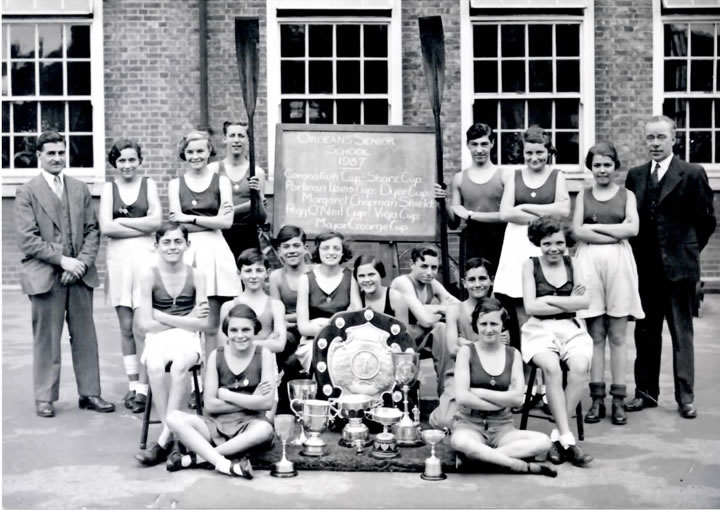
Orleans Senior School Team – Charlie Shore Regatta 1937
Courtesy Lesley Williams
The project has given local people the chance to record their memories and lend photographs and other documents about these various sites which have continued to generate a great deal of interest in the town over many years. It has also connected a number of people to the heritage of the area which would not have happened if the project had not taken place.
The project is run by the Richmond Environmental Information Centre (REIC) which received a £39,100 grant from the Heritage Lottery Fund.
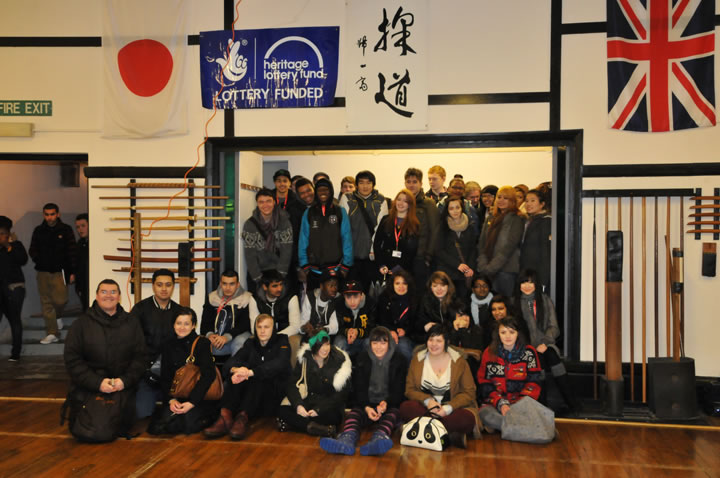
Students from Richmond upon Thames College at the Queen’s Hall
The first two months of the project were spent in preparation, purchasing equipment, learning to use equipment and software and discussing the project with Orleans Park School and Richmond College. It became clear that teachers at Orleans Park did not have the time to integrate the project into their work as the grant came at the wrong time in the school year. However, Richmond College Creative Arts and Media Department decided to come on board involving around one hundred students and six lecturers.
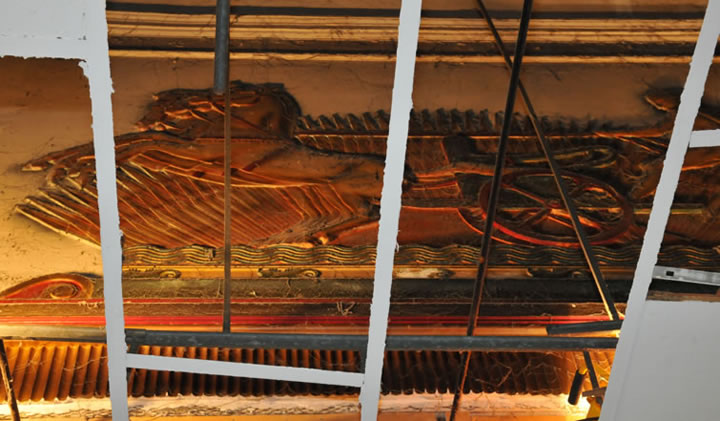
Newly uncovered frieze at the Queen’s Hall
The Richmond College students began their participation in the project at the beginning of January 2012 when they attended the unveiling of an historic frieze above a false ceiling in Queen’s Hall. The event was arranged by REIC members of the project team. Many members of the community and over one hundred students were invited. The local press and the Mayor were present and a volunteer took photographs of the frieze which had not been seen for around a hundred years.
At least six lecturers from the College were involved in the planning of the Memories of Twickenham Riverside project and were ready to start work on 3rd January 2012. The project was integrated into the curriculum and used in a variety of subject areas including painting, graphics, modelling and filming. Artwork, maps and models (of how the site might have been developed) were produced for the students’ end of year exhibition in July 2012. During the spring and summer terms oral history training was given, interviews, filming and editing took place and a DVD produced.
The amount of liaison and preparation by the project team for the film crews was very time consuming. Between one and two days a week were needed for preparation including reminiscence sessions with interviewees. Filming usually took between half a day to a day and members of the project team arrived early to introduce the interviewees to the film crews. Of course, all interviewees had to be met and briefed initially by members of the project team.
One interviewee, Edward Davies, wrote about the project: "it does look rather good and I congratulate you on having the idea and then making it work. As one of the interviewees, I got to experience first hand how much effort went into “delivering” just my little piece”.
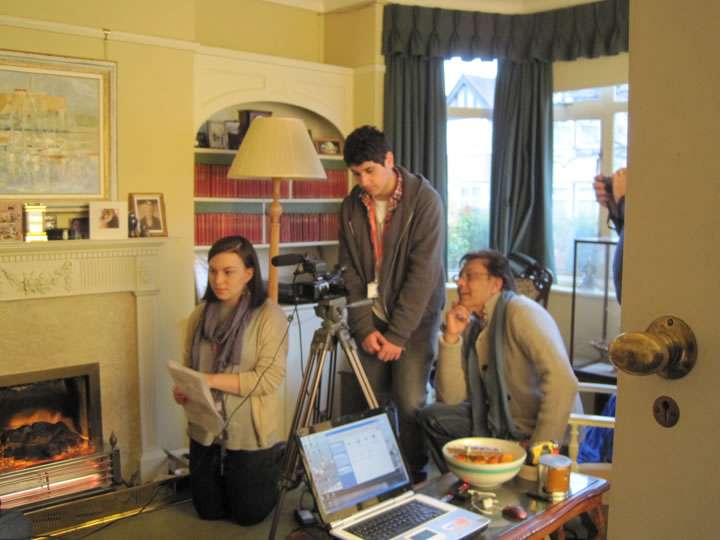
Students/volunteers filming and interviewing
The college worked on the project for two terms. Filmed interviews were carried out with twelve members of the community. Other members of the community were interviewed by volunteers and took part in reminiscence sessions but not filmed, mainly because they were not available at the same time as the student film crews.
Filming took place in the homes of interviewees, mostly on Eel Pie Island, in the historic Council offices of York House near the Embankment and Twickenham Rowing Club (also on Eel Pie Island). None of the students had been on Eel Pie Island before so it was quite an experience for them; the island is a very idyllic spot, hidden away by dreary Twickenham High Street. One interview took place in the Barmy Arms pub on the Embankment, opposite Eel Pie Island, but unfortunately the sound quality was not good enough to use the interview for the DVD.
The students seemed to engage very well with some of the interviewees and were particularly interested to visit Trevor Baylis’ house which he built himself and hear Trevor’s stories of life on Eel Pie Island in his youth. Of course, the stories of the Eel Pie Hotel and the jazz and rock and roll legends who played there were always bubbling below the surface during many of the interviews.
Professor Jeremy Hamilton-Miller was another of the interviewees and he and Sue Hamilton-Miller led the research on Richmond House and the pool site. Jeremy also contributed to research on the Charlie Shore Boat House.
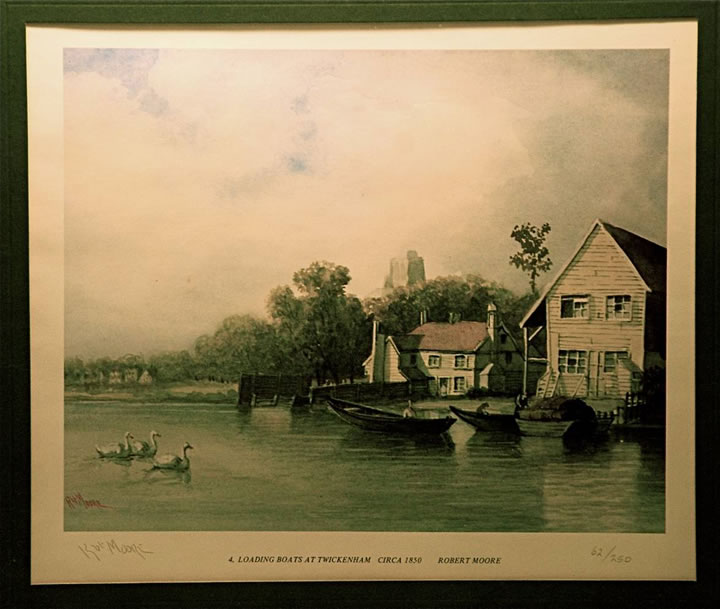
Copy of painting received from Nevada, USA
Courtesy of Fred Stahl
The work on Queen’s Hall led to research being carried out by volunteers to trace members of the American Air Force who visited Queen’s Hall for dances during the Second World War while they were stationed at Bushy Park. Contact was made with a few surviving former air force personnel by email. Assistance was given by the historian at Bushy Park. The project team was also surprised to receive a copy of a print of an old painting of Twickenham from Fred Stahl of Lake Tahoe, Nevada, USA who had read about the project online at This is Local London. Correspondence took place with him and a few members of the community about the history connected to the painting.
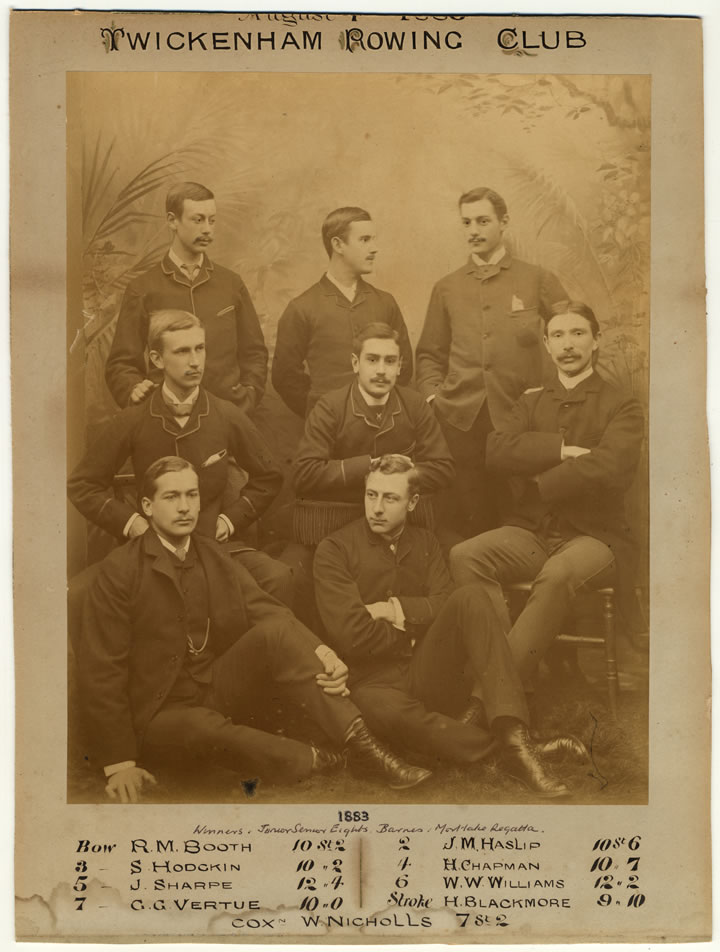
Twickenham Rowing Club team 1883
Courtesy of Twickenham Rowing Club
Twickenham Rowing Club provided photographs for the exhibition in June (attended by HRH Princess Alexandra). There was great interest in the project at the club and filming took place with Michael Salzman who spoke about the club’s history and its historic connection with the French royal family. Other club members were also interviewed although not available for filming.
Project banner in Church Street, Twickenham
A licence from the Council was obtained to hold street stalls in the High Street and the Memories of Twickenham Riverside banner in Church Street advertised the project. The street stall was located very near the entrance to Queen’s Hall and within sight of the location of the former Charlie Shore Boathouse which are two of the sites studied.
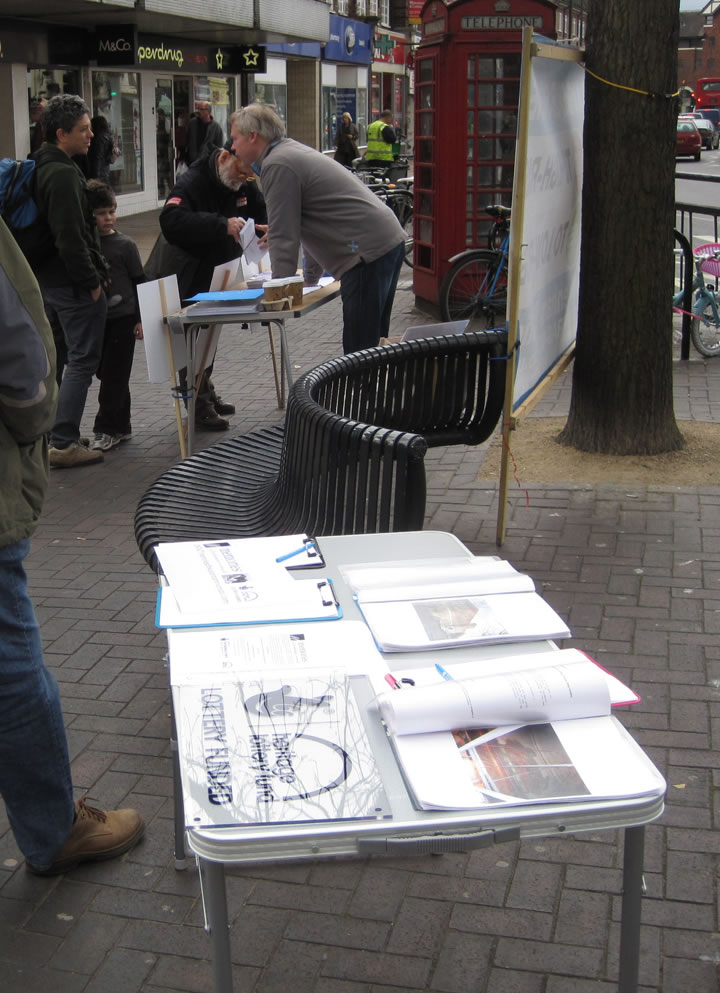
Project street stall in King Street, Twickenham
A street stall in Twickenham town centre was a good way of engaging people with the Memories of Twickenham Riverside. Information was collected from local residents and photographs were volunteered. Articles about Memories of Twickenham Riverside, especially the unveiling of the frieze in Queen’s Hall, also featured in the local paper. Additionally, an advertisement asking for people to come forward with memories was put in local newspapers.
The project manager directed Memories of Twickenham Riverside liaising with the Steering Group which consisted of those working on each of the sites (Richmond House, the pool site, Charlie Shore’s Boathouse and Regatta, Twickenham Rowing Club including the Eel Pie Island area) as well as members of the REIC Committee. The project manager and educational consultant liaised with lecturers from Richmond College from the Creative Arts and Media department.
Members of the project team initially met with a mentor (a member of the Oral History Society) but the local college became heavily involved in the project and training came via the lecturers who gave considerable time to Memories of Twickenham Riverside; a number of aspects relevant to the project were covered. The project also benefited from the previous work of the educational consultant who has a number of years of experience of working with community history projects.
Extensive archival research, especially into Richmond House, has been carried out under the supervision of an expert volunteer who is experienced in this field. This part of the project has proved to have one of the most successful outcomes as primary research has produced surprising results leading to new discoveries daily.
Media training has been given from local people involved in filming as well as the college media department (the film industry has traditionally been important in the area). Volunteers of the Memories of Twickenham Riverside project have taken part in both filming and editing
It has already been said that because of the lateness of receiving the grant, one term into the school year, the role of Orleans Park students was taken over by the Creative Arts and Media students from Richmond College. The college came on board wholeheartedly and Memories of Twickenham Riverside was fully integrated into the curriculum. Artwork, maps and models relating to the project were produced by the students and eventually shown at the college exhibition in July 2012. Oral history training was given, interviews conducted and filmed and a DVD produced. A transcription of the final filmed output is on the Memories website.
The first exhibition of the Memories of Twickenham Riverside project took place on Diamond Jubilee Gardens (the site of the old pool site and the former garden of Richmond House) on 23rd and 24th June 2012. A very large collection of old photographs and written information was on display. Over two thousand local people attended the opening and visited the exhibition including HRH Princess Alexandra who spent quite a lot of time discussing the photographs with local people.
An afternoon and nighttime display of the Memories of Twickenham Riverside photographs took place in the Diamond Jubilee Gardens (the site of the old pool) on 30th November during a Christmas celebration for members of the local community.
The documentary DVD was produced by the students of the Media Department of Richmond College in liaison with the project manager, the educational consultant and a number of volunteers. The video was shown at the students' end of year exhibition in July 2012.
Talks and PowerPoint presentations were given to various groups of people in Twickenham on 18th September 2012 and 5th and 21st February 2013. These were preliminary introductions to a booklet on Richmond House.
Over the course of the project a website has been developed: http://www.memoriesoftwickenhamriverside.com and output from the project is available on the site. The Memories of Twickenham Riverside project is linked and featured on World InfoZone, a leading educational website.
The success of the exhibition at the opening of the Diamond Jubilee Gardens (the old pool site in the former gardens of Richmond House) produced an amazing synergy between the Memories of Twickenham Riverside project and the old pool site. Following this success it was agreed with the Heritage Lottery Fund to buy a good quality weather-proof gazebo so the exhibition could be incorporated in other events in Diamond Jubilee Gardens.
The Council would like the REIC to exhibit the project as often as feasible in the Gardens. Plans are being considered to build community buildings next to the Diamond Jubilee Gardens and it is expected that the exhibition may be housed in this complex if building goes ahead in the next few years.
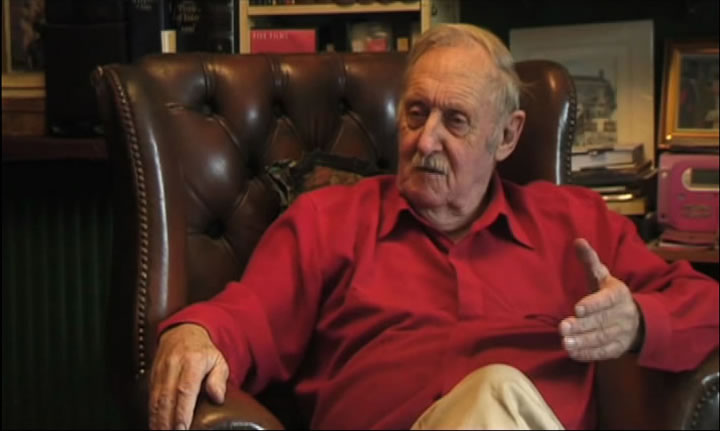
Trevor Baylis being interviewed by students/volunteers
Overall, the project team thought that our key aims for the Memories of Twickenham Riverside were met:
The acquisition of new skills such as archival research and oral history collection;
The promotion of public awareness of Twickenham’s heritage, particularly through the education sector;
Increased appreciation and understanding of the history and the environment of the River Thames;
Collaboration with teachers to develop project activities and material for students.
With regard to involving the wider community with their heritage, advantage was taken of the interest in the recent campaign to save Twickenham Riverside to encourage people to take part in a project for present and future generations.
Many of the students who took part in the Memories of Twickenham Riverside project had never been to Twickenham Riverside (as it is hidden away behind a parade of office buildings and shops) and the project aimed to encourage students to take an interest in the riverside and heritage.
The final output target of the project was to record, and secure for the future, memories of Twickenham Riverside before they are lost forever. Project output is in the form of photographs and written material as well as audio and video recordings. This is all on the Memories of Twickenham Riverside website and linked as a feature on the worldinfozone.com website which has not only a good national reach but also an international reach.
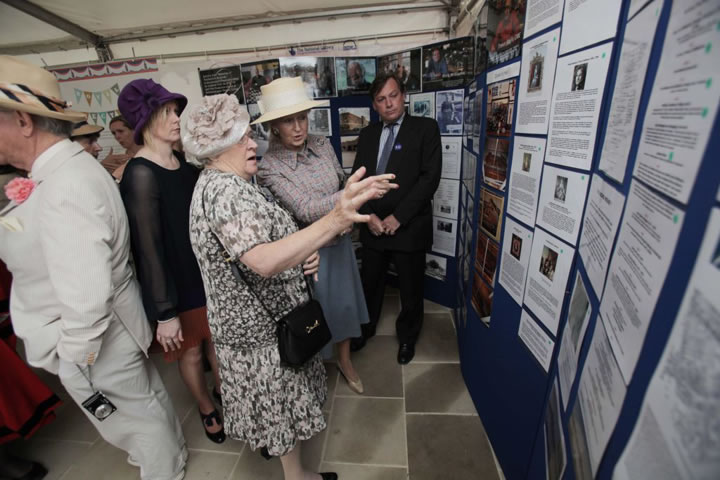
HRH Princess Alexandra visits the project display at Diamond Jubilee Gardens
The Memories of Twickenham Riverside project has encouraged people from a variety of walks of life to learn about their heritage and will conserve Twickenham Riverside’s memories for present and future generations.
The first exhibition of the Memories of Twickenham Riverside project took place on Diamond Jubilee Gardens (the site of the old pool site and the former garden of Richmond House) on 23rd and 24th June 2012. Over two thousand local people attended the opening and visited the exhibition including HRH Princess Alexandra. During the following months opportunities were taken to exhibit Memories of Twickenham Riverside at various outdoor events.
On 18th September 2012 a PowerPoint presentation about Richmond House and Charlie Shore and his Regatta took place at an Ordinary General Meeting of the REIC. Members and non-members of the REIC attended this very successful presentation. The students’ DVD Memories of Twickenham Riverside was first shown to the REIC at a meeting on 25th October, although it had been screened at the students’ end of year exhibition.
An afternoon and nighttime display of the Memories of Twickenham Riverside photographs took place in the Diamond Jubilee Gardens (the site of the old pool) on 30th November during a Christmas celebration for members of the local community.
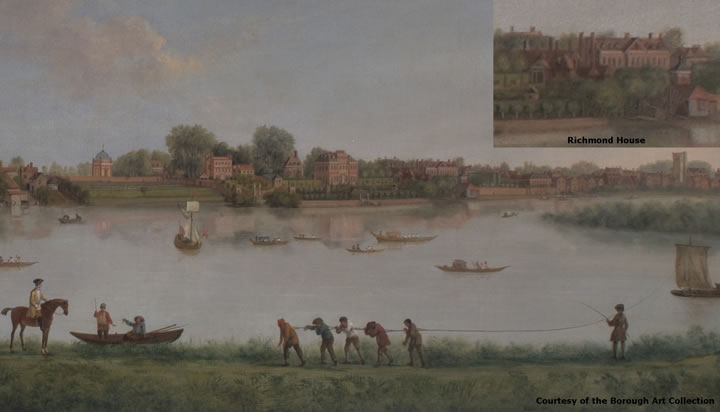
Painting by Peter Tillemans showing Richmond House
Courtesy of Richmond Borough Art Collection, Orleans House Gallery
On 5th February 2013 an illustrated talk on Richmond House was given by Sue Hamilton-Miller to the Richmond and Twickenham Wives Fellowship, an interdenominational group set up during the First World War to provide support to wives whose husbands were away fighting.
“With only an hour in which to talk a whistle stop tour of the lives of the inhabitants of the house was given, relating in particular to subjects that are still in existence today thanks to the endeavours or social standing of the people who lived in the house, covering a period from 1635 to 1935. Such diverse subjects included Oliver Cromwell's funeral, the Elgin Marbles, Dorchester Hotel, Strawberry Hill House and Horace Walpole, Prime Ministers and Chelsea Football Club.
What is so astonishing is that almost no-one has heard of the rich and varied story of this house (I certainly hadn't until I started my research); no-one in the room on Tuesday was aware of it. I received several appreciative phone calls the next day and look forward to educating a wider audience, so that in future Richmond House can take its place amongst the other great houses that are known about along this historically important stretch of the River Thames in Twickenham."
Another very interesting talk was given by Sue Hamilton-Miller to the Twickenham Society on 21st February 2013 (and again to another community group on 26th March) about the first two hundred years of Richmond House and some of the people who lived there. It seems that among those who lived in the house was a Mr Middleton who signed the American Declaration of Independence and also Lady Shelburne who is an ancestor of Kate Middleton, the Duchess of Cambridge.
The amount of research carried out by Sue is very impressive. She and Jeremy Hamilton-Miller have spent many hours in archives delving into the history of Richmond House, peering at Latin scrolls and Wills and corresponding with historians around the country. When asked about her research, Sue said it took hours but in fact it has become a labour of love with Sue finding out something new every day about Richmond House and its fascinating inhabitants; people who walked along Twickenham riverside and the historic streets in the area. (Primary research took place at the National Archives at Kew, the London Metropolitan Archives in Islington, the Quakers Archives at Euston, Hertford County Archives, the Company of Watermen Archives and the Land Registry, to name but a few sources).
Sue wrote about her involvement in the project:
"
As I come to the end of my project, the history of Richmond House, people are asking me how much I have enjoyed doing it and have I found out anything interesting. The answer to the first is a bit like the curate's egg, nice in parts! “An astonishing amount” is my second answer.
I embarked on this venture with the idea that I would have a relatively small number of people to report on, with possibly a couple of sentences about them – maybe enough to fill a leaflet. The reality is that there is a tale to tell about all 25+ families – and what a tale!
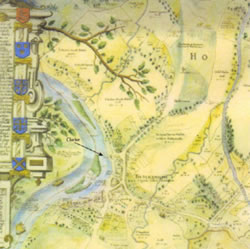 Never having done anything like this before, I started by looking at the bible for local history, the Twickenham Museum website, and found a list of people who were believed to have lived in Richmond House from about 1650 up until it was demolished in 1927. Taking a name at random, Lambert Blair, someone whose memorial tablet I look at every Sunday in Church, I googled his name to see what charitable works he had done, only to discover to my astonishment that he and his family made their money out of slavery. I then looked at the first name on the list, Edward Birkhead, only to find out that he had taken part in Oliver Cromwell's funeral procession. With that I was hooked and the whole project has taken over my life for the past few months.
Never having done anything like this before, I started by looking at the bible for local history, the Twickenham Museum website, and found a list of people who were believed to have lived in Richmond House from about 1650 up until it was demolished in 1927. Taking a name at random, Lambert Blair, someone whose memorial tablet I look at every Sunday in Church, I googled his name to see what charitable works he had done, only to discover to my astonishment that he and his family made their money out of slavery. I then looked at the first name on the list, Edward Birkhead, only to find out that he had taken part in Oliver Cromwell's funeral procession. With that I was hooked and the whole project has taken over my life for the past few months.
My husband has been hugely supportive and together we have visited Archives in our local Borough of Richmond upon Thames, Hertfordshire, London Metropolitan Archives and Kew Public Record Office. The Archivist at Westminster Abbey has been extremely helpful, we still have to visit the Westminster Archives to check out a few points and a further visit to Hertford is needed.
I have been met with huge support from the Weston Park archivist, who put me in touch with someone called Sally Goodsir who was extremely generous in allowing me to see the list of paintings that were in Richmond House in 1719, although her article about it hasn't yet appeared in print. The Fusilier Museum at the Tower of London immediately responded to my request to use their glorious painting of Field Marshal Sir Edward Blakeney in both talks and in the booklet. In fact wherever I have gone people have gone out of their way to help me and be generous with their time and knowledge, so much so that I felt I had entered another world. As a novice I needed to be shown how to handle ancient sometimes dusty scrolls nearly 400 years old – what a privilege, and how exciting to see Edward Birkhead's signature after all these centuries.
For the past month or so I have been struggling, way out of my comfort zone, to put down my research in a readable form. I am much more at home giving talks to societies when grammar and punctuation don't matter as much and it is ephemeral. I am about to give my third talk, with a fourth in the pipeline. And having discovered so much of interest I am having to split my talk into two or my audience would miss its last bus home!
Copyright law has proved a nightmare and I'm still on a steep learning curve. Having visited probably thousands of websites and read many books I am now scrambling to fit quotes with references and this part I am finding a chore, but it has to be done and time is running out. I know that lurking in archives there is still a wealth of knowledge to be discovered and I would be much happier doing that, rather than sitting typing. I'm hoping to continue the research without the pressure of having to work to a deadline and having copyright infringement breathing down my neck!
I would like to say thank you to those who have given me the opportunity and encouragement to explore new horizons and not sink into a quiet retirement. I have had a ball."

Students/volunteers filming and interviewing
The project has achieved its aims and made the outcomes available on the Memories of Twickenham Riverside website. Information discovered about Richmond House, through extensive primary research, has uncovered centuries of history in detail which was previously unknown.
Ten teams of three to five students from Richmond College had the opportunity to work on a project which was a real interviewing and filming experience and not just a college exercise. Working on Memories of Twickenham Riverside has given them a slightly wider view of the world and an insight into the riverside and its history which they would not have gained otherwise.
One problem that was experienced, and should probably be expected, is that it was found that some of those who volunteered did not always have enough time to work on the project; often extra work was taken on by the project manager and project team to make sure that the project tasks were kept on schedule.
Those who did take part in the Memories of Twickenham Riverside have acquired new skills which can be transferred to a range of occupations; skills in filming, editing, web design, graphics and collecting and cataloguing photographs. New interests have also been developed, not only by those directly involved in the project but by those who are benefiting from the information which is being disseminated.
Above all it is certain that the lives of some of the people working on Memories of Twickenham Riverside have been enriched considerably because of their involvement in the project.
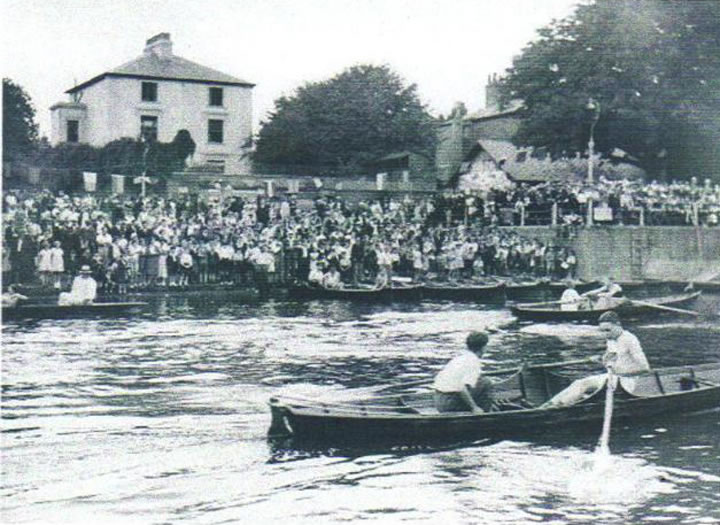
Charlie Shore Regatta
Courtesy of London Borough of Richmond upon Thames
The project has changed not only people’s engagement with their heritage but there have been unexpected outcomes which have changed the community’s enjoyment of Twickenham Riverside for the better. The following outcomes were partly a result of the REIC not achieving a successful first time bid for HLF funding.
Waiting to hear about the second (and successful) application the REIC decided to apply for a Civic Pride grant from the London Borough of Richmond upon Thames to re-enact the historic Charlie Shore Regatta for Boys and Girls which had been abandoned following the Second World War. This proved to be a very successful project with Twickenham Rowing Club partnering in organizing the races and Rosie Whitney-Fish producing a special “Charlie Shore dance” on the banks of the River Thames.
The Charlie Shore Regatta took place on the day of the Great River Race and Richmond Council asked members of the REIC if they would extend the Charlie Shore festivities so that events were happening in Twickenham, upstream from Richmond where the Great River Race ended. The Rugby Football Union became involved in sponsoring some of the activities and it was decided to make the whole weekend a festive occasion. This turned out to be one of the most successful events of the year; students from Richmond upon Thames College recorded one of the days on film. (The second “new” Charlie’s Regatta took place during the Jubilee celebrations).
In October 2012 confirmation was received that the REIC had received a grant for Memories of Twickenham Riverside and in January the HLF project started as described above.
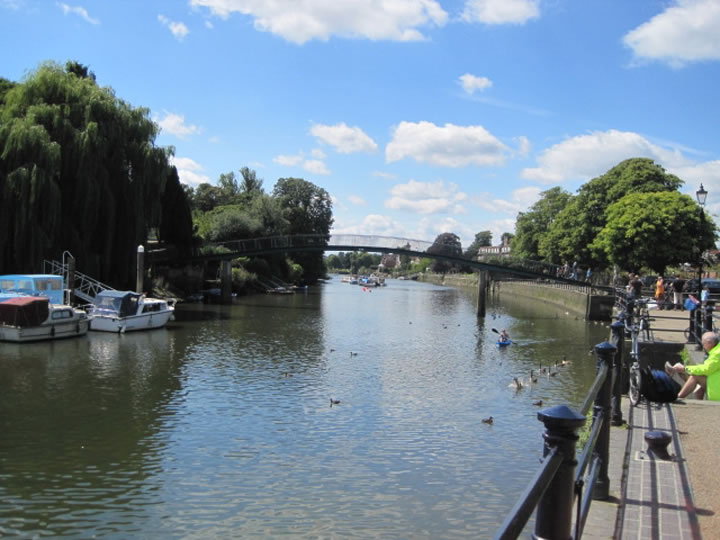
Twickenham Riverside
The partnership with the College is not the only enduring partnership which has emerged from the work on Twickenham Riverside. The RFU (Rugby Football Union), which everyone will know has its headquarters in Twickenham, has been impressed by the work of the REIC and others in the community and has formed a strong partnership with those working on Twickenham Riverside. The help and support from their community relations manager is invaluable. The London Borough of Richmond upon Thames has also been supportive and has allowed the REIC to exhibit the Memories of Twickenham Riverside on Diamond Jubilee Gardens. There is also a promise to find a permanent home for the exhibition once all the works have been carried out on land adjacent to the gardens.
Although the duration of the Memories of Twickenham Riverside has come to a conclusion, the project will live on in community initiatives, the exhibitions and presentations to community groups and there may be another and much longer book on Richmond House in the pipeline.
The end of the project was marked by the publication of a 40-page booklet Richmond House and its inhabitants, which provides a fascinating insight to the rich history of the house and includes extensive primary research. Two leaflets were also published on Queen's Hall and Charlie Shore - The Man and his Regatta.
And the last word comes from the filming crews:

Students/volunteers filming and interviewing
"It was a great opportunity for students to work for a client. This gave them an excellent chance to showcase their media and film production skills. Working in small teams or 'crews' learners went on location around Twickenham filming various interviews with the participants on Memories of Twickenham Riverside. Students also filmed the riverside area including shots of York House, Jubilee Gardens and Richmond Rowing Club."
On meeting and interviewing Trevor Baylis OBE one learner, Daniel, 17, said "I'd never met an inventor before, Trevor was an amazing guy, he had so much to talk about, he showed us the first wind up radio he ever made. The man is a legend!" Hannah Wright, Media Technician, Richmond upon Thames College.
Student A: "I really enjoyed working as part of a professional film crew. I learnt so much about location shooting, especially the lighting and sound aspects."
Student B: "This was a good experience for me. It was very different to the filming we have done in college. We got to go out into the local community and work together with local residents. The contributors were fantastic. They had so much information to give us! It was a difficult task in post-production, we had to extract the best bits about the history of Twickenham Riverside and edit the film to communicate these to the audience."
Student C: I gained a wonderful insight into the world of Twickenham and met a range of interesting people full of great anecdotes.
Student D: I found this experience very insightful and thoroughly enjoyed it and would jump at the chance to do it again as I valued working with people of such high calibre.
Student E: This project was a great experience for me. It was not just a form of technical work experience, but it also taught me more about the local area. I found the whole experience enjoyable and interesting.
The project DVD filmed with the students was screened on 1st May 2013 at the Edmund Kean Theatre, Richmond upon Thames College.
Final comment from Professor Jeremy Hamilton-Miller, Chairman of the REIC:
"Working on this project has been an eye-opener and mind-expander. I spent my professional life doing medical research and writing papers, but rapidly discovered that historical research is a completely different challenge. While I found reading 17th century legal script possible after some practice, the legal Latin defeated me (I gave up the subject 60 years ago). On the other hand, I felt I had almost got to know the 19th century Charlie Shore and his family, and the Queens Hall came alive when we were able to see parts of the original. I hope that our combined work may have played a small part in the (alas temporary) reprieve of the latter from the developers' clutches.
On the larger aspects, I have been most impressed by the spirit of teamwork inspired in the students by Teresa and Berkley. Inevitably there have been a few hiccups, but the contrast between the original “raw data” (rushes?) - the students' first videos – and the finished article, in terms of technical quality and audience appeal, is quite remarkable. The project will make a significant contribution to the existing sum total of local history, and will also be of lasting interest to many outside the Borough."
The Richmond Environmental Information Centre (REIC) is a charity established to:
Advance the education of the public in ecology, environmental studies, resource conservation and natural history Promote the conservation, protection and restoration for the public benefit of the natural resources, the lands and buildings of historic interest of the London Borough of Richmond upon Thames. (www.richmondenvironment.com)

